We Fund the Police
How Much? What Has Changed?
Few fiscal realities are the subject of as much public attention as the size of the New York City Police Department (NYPD) budget. Last year, the Citizens Budget Commission (CBC) found that the adopted budget reduced planned fiscal year 2021 City-funded spending for the NYPD by $474 million, less than half of the $1 billion cut called for by some activists and elected officials. Adjustments since budget adoption slightly increased that reduction to $490 million. Fiscal year 2021 NYPD City-funded spending, including the agency budget and centrally allocated costs, is now projected to total $9.7 billion, a decline from the $10.3 billion in City-funded expenditures in fiscal year 2020.1
However, this projected decline may be overstated because the NYPD appears to have been unsuccessful at restricting overtime spending, where most of the reductions were concentrated.2 The adopted fiscal year 2021 overtime budget was $268 million. However, through June 10, 2021, NYPD has already spent $418 million on overtime.3 CBC projects that total fiscal year 2021 overtime spending will reach $448 million, 67 percent or $180 million over budget.4 Thus, the actual fiscal year 2021 decrease in NYPD spending may be 37 percent less than the $490 million planned.5
This year’s Executive Budget allocates $10.5 billion of City funding to the NYPD for fiscal year 2022, a $728 million or 7.5 percent increase from the current fiscal year 2021 budget (agency and central costs). Fiscal year 2022 overtime is budgeted at $434 million; a level that will be difficult to achieve without diligent management. Furthermore, the budget understates likely spending on employee compensation. Collective bargaining agreements with unions representing many of the uniformed officers have expired; funding for those and future raises will not be reflected in the NYPD budget until a new set of agreements are ratified.
Updates to the Fiscal Year 2021 Budget Increase Planned Reductions to $490 Million
The Fiscal Year 2021 Adopted Budget reduced the NYPD City-funded budget by $474 million, comprised of $414 million for agency operations and NYPD-attributable central costs of $59 million (fringe benefits, pension contributions, and debt service). 6 (See Table 1.) Most of the savings were due to reductions to both civilian and uniformed overtime ($354 million), and the cancellation of the July 2020 Police Academy class that would shrink uniformed headcount by 1,163 positions to 35,007, which would save $86 million.7 When the Adopted Budget agreement was announced in June 2020, in addition to the $474 million discussed above, the Mayor’s Office also included the value of shifting School Safety Officers into the Department of Education (DOE) and School Crossing Guards into the Department of Transportation (DOT), for an additional NYPD budget “reduction” of $350 million.8 However, this has not been reflected in budget documents to date and no timeline has been given for the shift.
Since June 2020, the City has further reduced the NYPD operating budget by $11 million and NYPD-attributable central costs by $5 million, bringing total reductions to $490 million. These changes include new savings of $48 million, primarily from a vehicle purchase freeze, that were offset by $39 million in IT-related needs and other new spending. (See Appendix 1.)
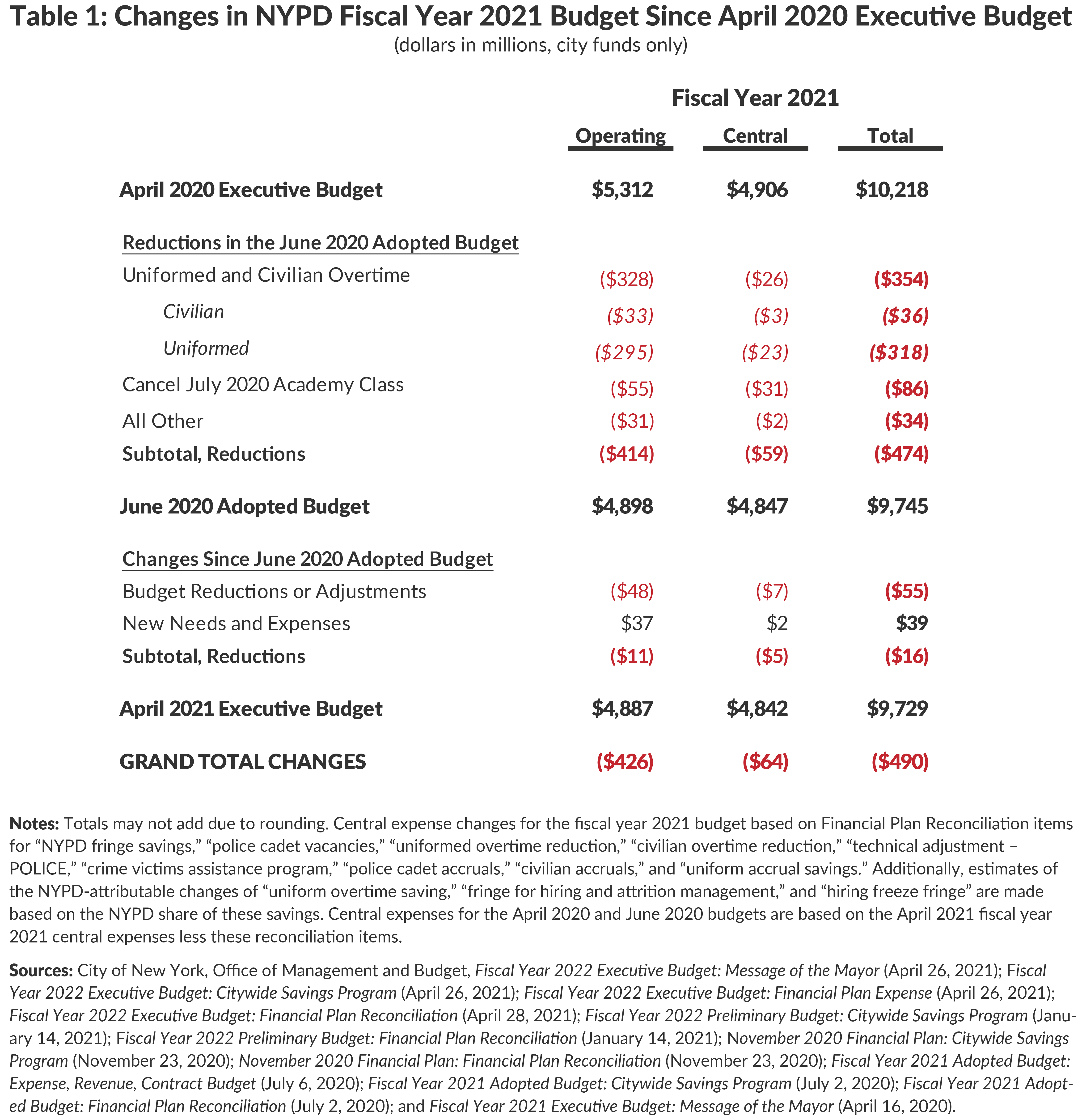
The Fiscal Year 2021 Adopted Budget reduced planned overtime spending unrealistically—to $268 million—from a high of $837 million in fiscal year 2020. As of June 10, 2021, NYPD spending on overtime already had exceeded its full year budget by $150 million, or 56 percent. At the current spending rate, CBC projects full-year NYPD overtime spending will be $180 million (67 percent) over budget for fiscal year 2021.9 (See Figure 1.) This projected overtime spending would shrink the NYPD fiscal year 2021 planned budget cut from $490 million to $310 million, or about 37 percent.
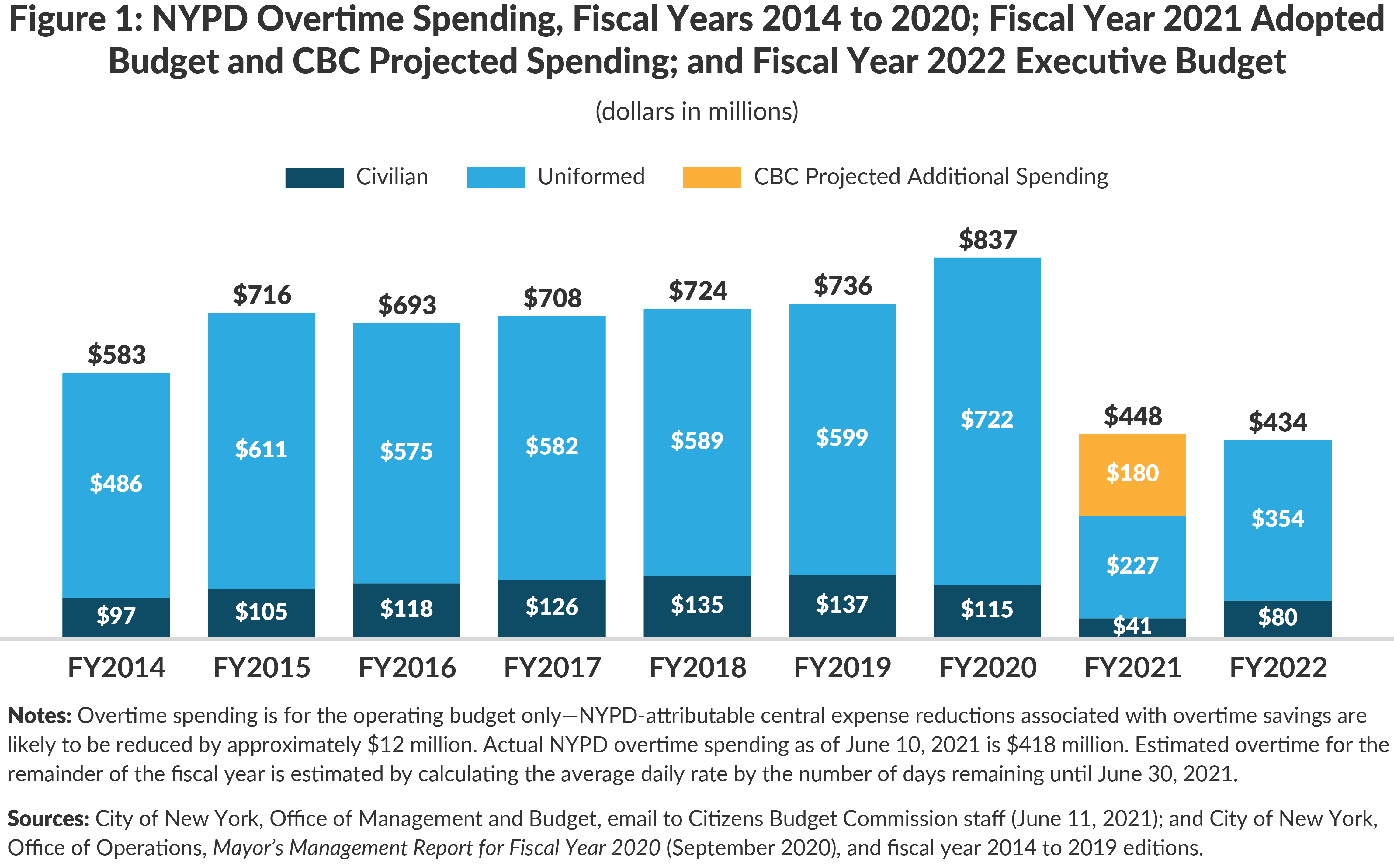
Total Fiscal Year 2022 NYPD City-Funded Spending Is Projected to Grow $728 Million to $10.5 Billion
Planned fiscal year 2022 City-funding for the NYPD currently is $10.5 billion, a 7.5 percent increase from the current plan for fiscal year 2021. (See Figure 2.) The operating budget increases from $4.9 billion to $5.1 billion, mainly due to higher budgeted overtime. NYPD-attributable central expenses increase from $4.8 billion to $5.3 billion.10 However, spending in fiscal year 2022 even may be higher once collective bargaining agreements are settled and if overtime again exceeds its budget.
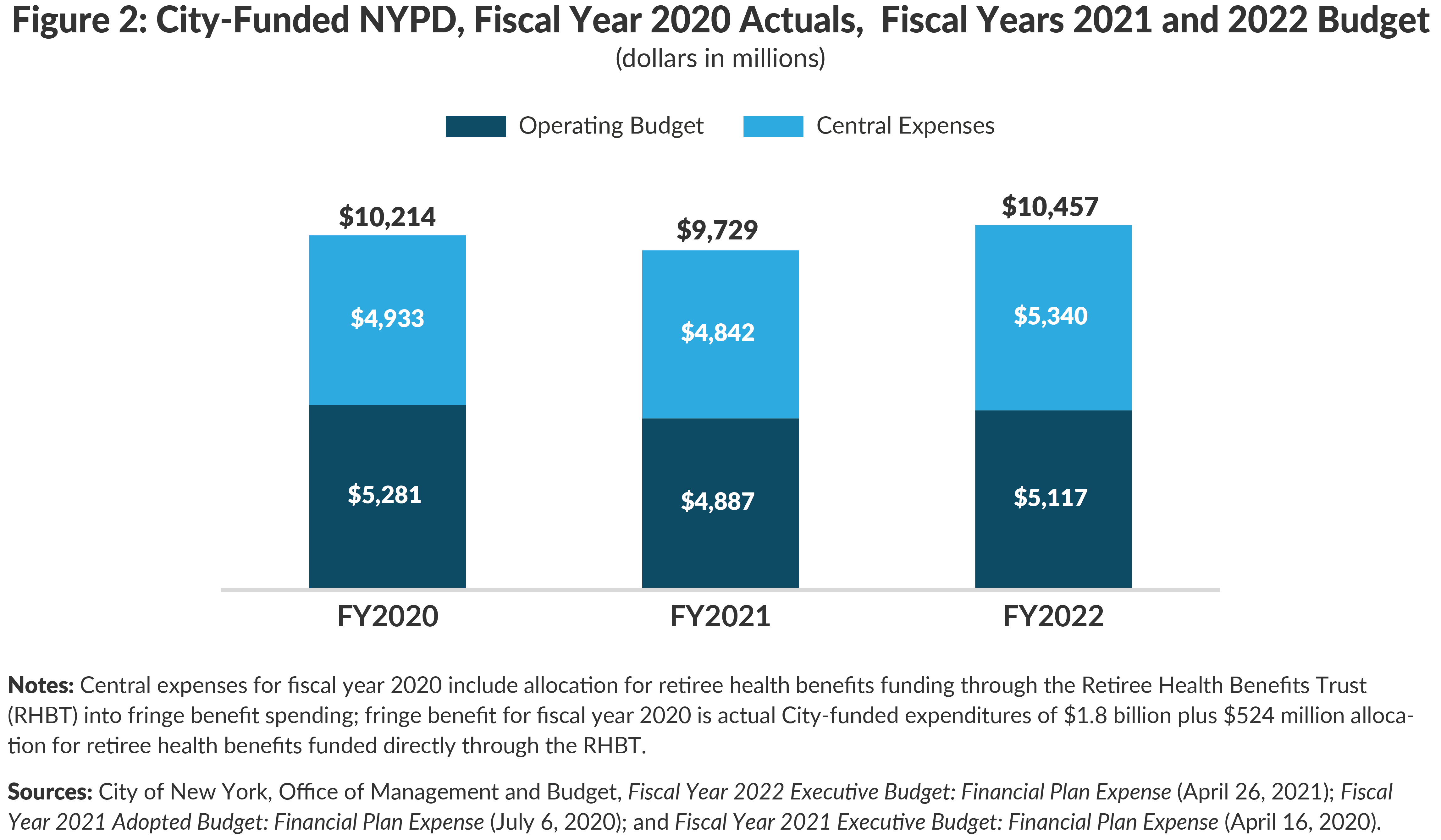
Between June 2020 and April 2021, planned fiscal year 2022 City-funded spending for the NYPD has been reduced $268 million. This reduction is comprised of the ongoing value of the cuts made to fiscal year 2021, plus additional reductions. Only $117 million of the $474 million in fiscal year 2021 cuts made in June 2020 recur in the fiscal year 2022 budget. (See Table 2.) Subsequent to fiscal year 2021 budget adoption, the City reduced planned fiscal year 2022 spending for uniformed overtime by $181 million and implemented a vehicle purchase freeze to save $38 million.11 These were offset $90 million by new spending, mainly for police reform initiatives and IT-related needs. (See Appendix 2.)
These reductions brought the fiscal year 2022 overtime budget to $434 million, close to CBC’s fiscal year 2021 expenditure projections. However, keeping spending at this level will require diligent management. While fiscal year 2021 overtime spending is lower than in recent history in large part due to extraordinary circumstances relating to the COVID-19 pandemic, overtime spending averaged $714 million annually the prior seven years. The resumption of activities as the economy re-opens will put upward pressure on fiscal year 2022 overtime expenditures. For example, in fiscal year 2017, $174 million in uniformed overtime (30 percent) was due to events, such as parades, many of which currently are not occurring.12
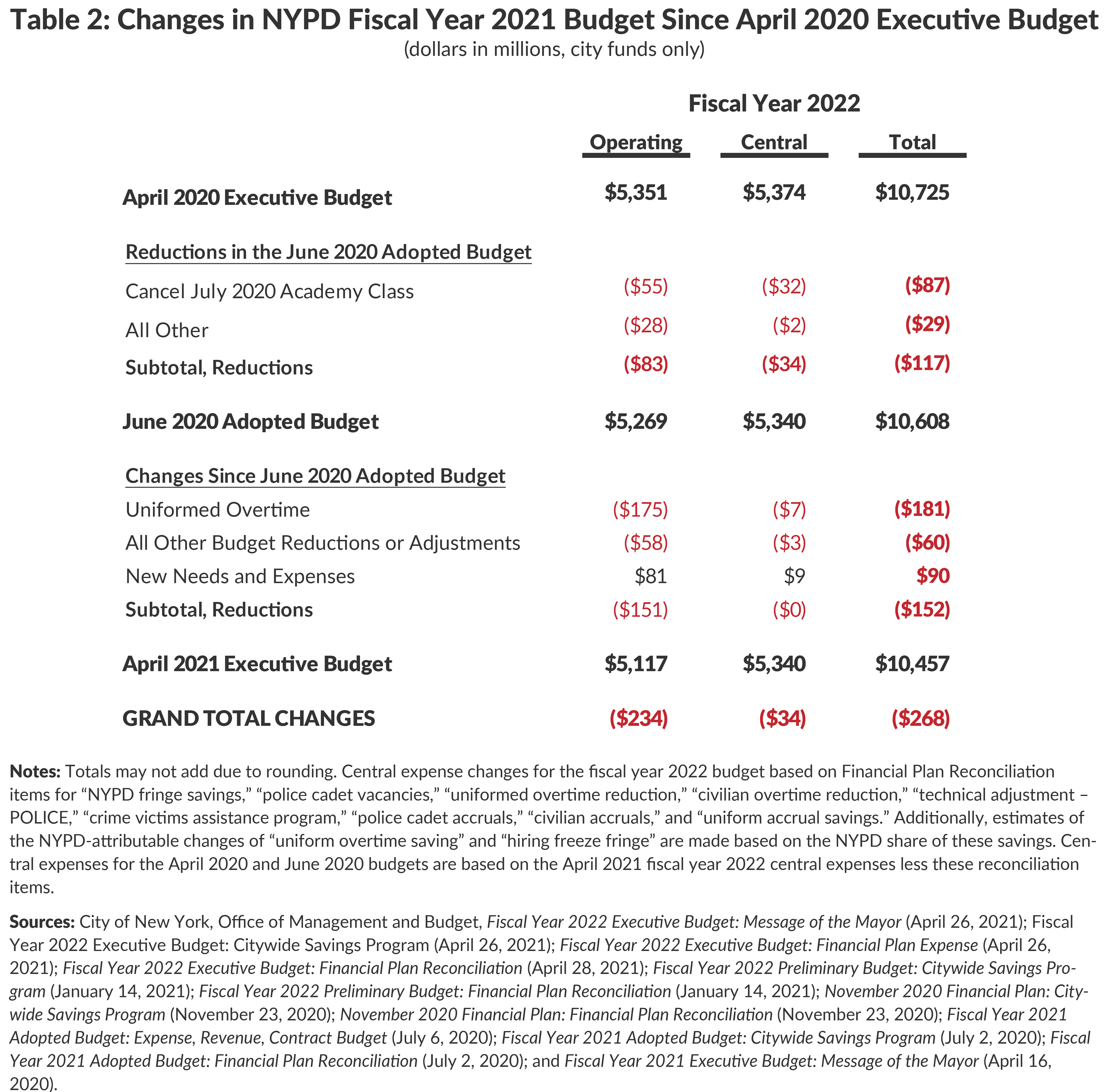
Currently, the NYPD budget does not reflect salary increases for either expired or future collective bargaining agreements (CBAs). Once the CBAs are settled and the City adjusts the NYPD budget accordingly, fiscal year 2022 expenditures likely will be higher than currently budgeted. CBAs for the majority of the NYPD workforce remain unsettled, including the Police Benevolent Association (PBA, expired 2017), the Sergeants Benevolent Association (SBA, expired 2018), and the Detectives Endowment Association (DEA, expired 2019).13 The PBA opted for binding arbitration, which has been delayed due to the pandemic. While the City has resources in the centrally-managed labor reserve to fund the current uniformed CBA pattern for these unions—CBC estimates the cumulative value of the current pattern of raises through fiscal year 2021 is about $350 million for the PBA alone—those funds will not be reflected in the NYPD budget until an agreement is ratified.14 Furthermore, if the arbitration decision is higher than the pattern, the City would need to provide additional resources to fund the increase.
The City also has limited resources set aside for the next round of contract negotiations. The City’s labor reserves for the next round of CBAs, which already have started to expire, only contains funding for a one percent raise starting in the third year. If raises above this level are agreed to, additional resources will need to be added to the budgets of the NYPD and other agencies.15 For example, for the NYPD, raises of 2 percent annually would be about $150 million in the first year (both agency and central costs), increasing to $450 million by the third year.16
Conclusion
When the current fiscal year is complete, it is likely that NYPD spending for fiscal year 2021 will have been $310 million lower than previously planned due to actions taken in adopting that budget. While modest savings will continue and have been proposed for fiscal year 2022, the Executive Budget’s planned City-funded spending is $10.5 billion, a $728 million increase from the current plan for fiscal year 2021. Furthermore, the budget’s plan for overtime may be exceeded, if past is prologue, and spending will be higher than the budget once arbitration is complete and new contracts are negotiated.
Download Blog
We Fund the Police: How Much? What's Changed?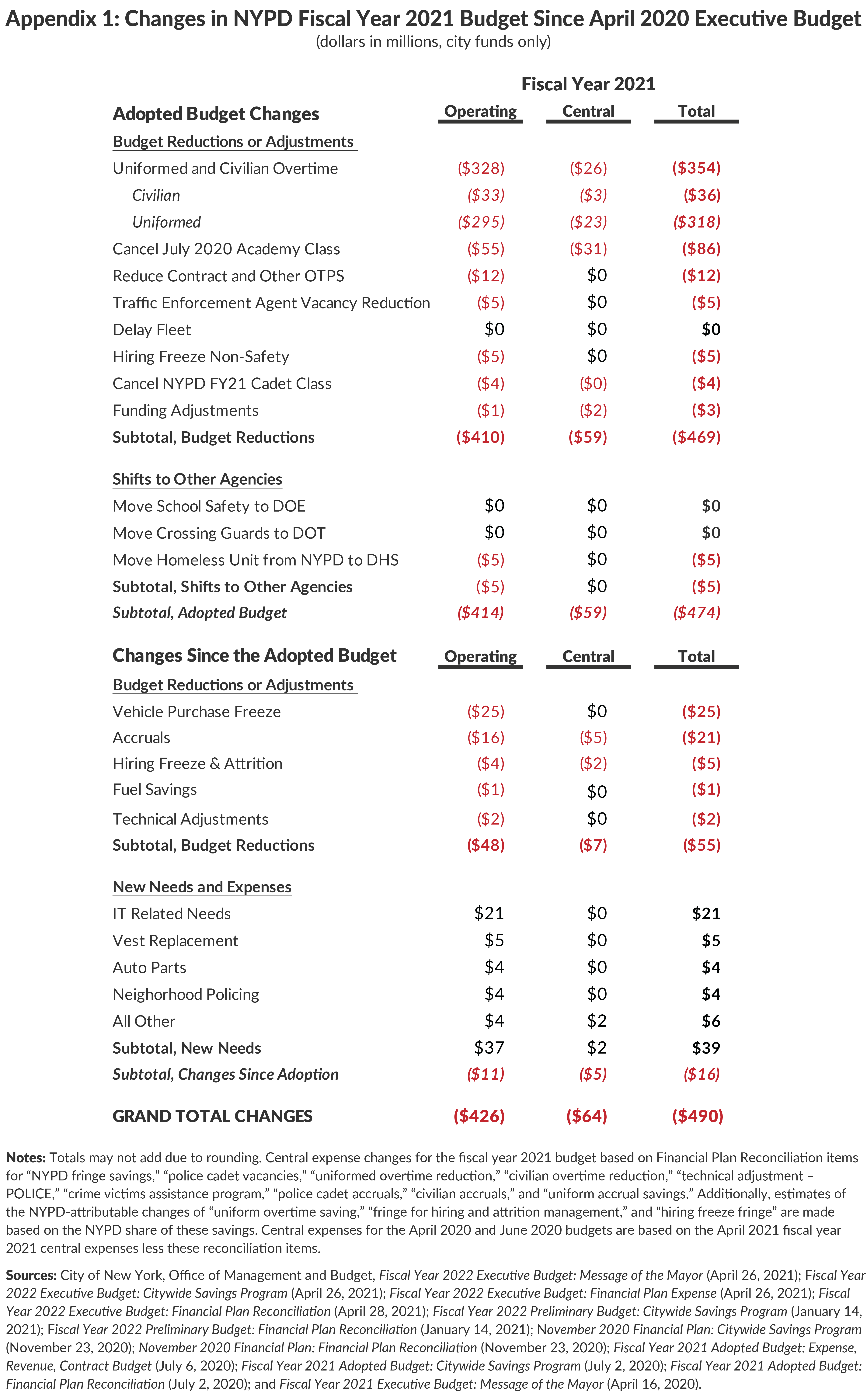
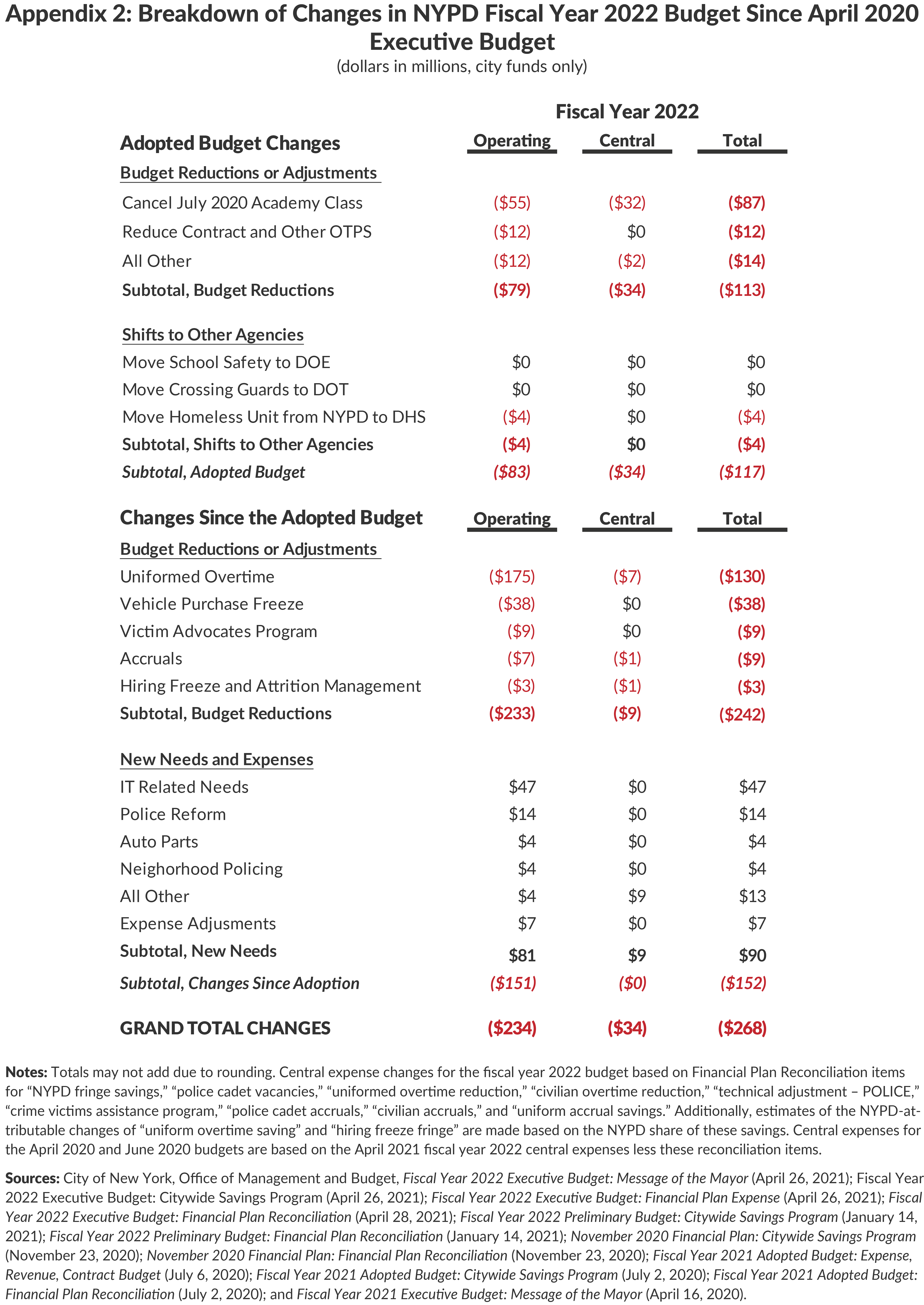
Footnotes
- CBC’s estimate of centrally allocated fringe benefit for fiscal year 2020 is actual City-funded expenditures of $1.8 billion plus $524 million allocation for retiree health benefits funded directly through the Retiree Health Benefits Trust (RHBT). City of New York, Office of Management and Budget, email to Citizens Budget Commission staff (June 11, 2021).
- Overtime reductions were 75 percent of the fiscal year 2021 cuts. Total overtime spending and the net impact on NYPD expenditures will not be available until the audited financial report is released in the fall. Underspending in other areas of the NYPD budget may offset some of the overtime overspending.
- City of New York, Office of Management and Budget, email to Citizens Budget Commission staff (June 11, 2021).
- The Office of Management and Budget (OMB) projects fiscal year 2021 NYPD overtime to reach $449 million, however, OMB also projects that will be offset by additional revenue, for net overtime of $429 million, $161 million over the adopted budget (56 percent). City of New York, Office of Management and Budget, email to Citizens Budget Commission staff (June 11, 2021).
- This is relative to the Executive Fiscal Year 2021 NYPD Budget (April 2020).
- City-funds are used for this analysis as federal funds are typically realized throughout the fiscal year and are often not included earlier in the budget cycle, distorting plan-to-plan changes. The City budgets certain costs centrally for all agencies, including most fringe benefits, pension contributions, and debt service for long-term bonds supporting the City’s capital program. Select budget publications allocate these costs to individual agencies. The appropriate measure of spending on an agency is the combination of agency and central costs. These reductions are measured against prior planned spending, as of the April 2020 Fiscal Year 2021 Executive Budget, and include both the agency budget and centrally budgeted expenses.
- The FY2021 forecast is for 35,007 uniformed and 16,948 civilian positions, for a total of 51,955. The FY 2020 year-end actual headcount was 53,416: 35,910 uniformed and 17,506 civilian; actual headcount for March 2021 was 51,335, 35,140 uniformed and 16,195 civilian. For more information on NYPD headcount, see: Ana Champeny and Adrian Pietrzak, NYC Employee Headcount, Citizens Budget Commission (March 22, 2021), https://cbcny.org/research/nyc-employee-headcount.
- Does not reflect central costs as those are paid for centrally regardless of which department the function is housed in.
- Central costs for fringe benefits and pensions may also be higher than budgeted due to the overtime spending. OMB projects fiscal year 2021 NYPD overtime to reach $449 million, however, OMB also projects that will be offset by additional revenue, for net overtime of $429 million, $161 million over the adopted budget (56 percent). City of New York, Office of Management and Budget, email to Citizens Budget Commission staff (June 11, 2021).
- The City budget does not provide a breakdown on the $498 million increase for City-funded central costs. The all funds increase is $601 million, of which $328 million is for fringe benefits, $226 million is for pensions, and $47 million is for debt service. City of New York, Office of Management and Budget, Fiscal Year 2022 Executive Budget Message of the Mayor (April 26, 2021), https://www1.nyc.gov/assets/omb/downloads/pdf/mm4-21.pdf.
- OMB indicated that, of the $14 million added for Police Reform initiatives, $2.6 million increases the overtime budget. The CBC tables reflect this increase in the line for police reform. However, including the adjustment would bring the overtime reduction from $181 million to $178 million. City of New York, Office of Management and Budget, email to Citizens Budget Commission staff (June 11, 2021).
- See: Council of the City of New York, Report of the Finance Division on the Fiscal 2019 Preliminary Budget and the Fiscal 2018 Preliminary Mayor’s Management Report for the New York Police Department (March 12, 2018), www.council.nyc.gov/budget/wp-content/uploads/sites/54/2018/03/FY19-New-York-Police-Department.pdf.
- City of New York, Office of Labor Relations, “Collective Bargaining: Recent Agreements & Prevailing Rate Consent Determinations,” (accessed June 13, 2021), https://www1.nyc.gov/site/olr/labor/labor-recent-agreements.page.
- Assumes each point for PBA costs the City $24 million, based on prior PBA collective bargaining agreements.
- Collective bargaining increases would increase spending across all agencies.
- Calculation assumes that each point increase in labor costs for NYPD is $75 million, or 16 percent of the Citywide estimate of $460 million. NYPD is 16 percent of City headcount.